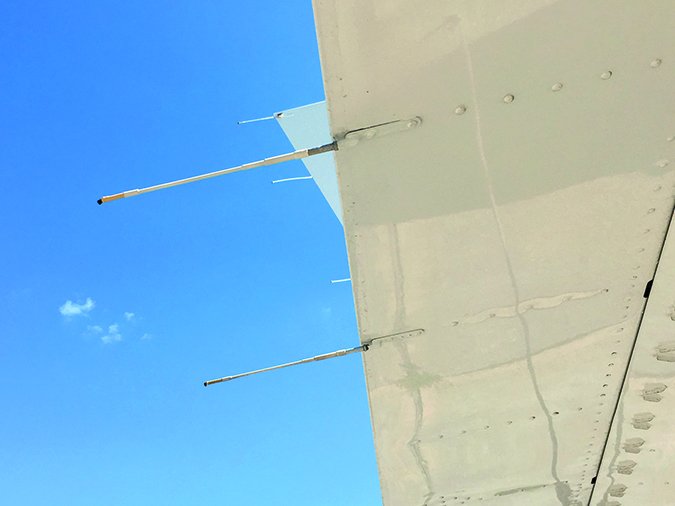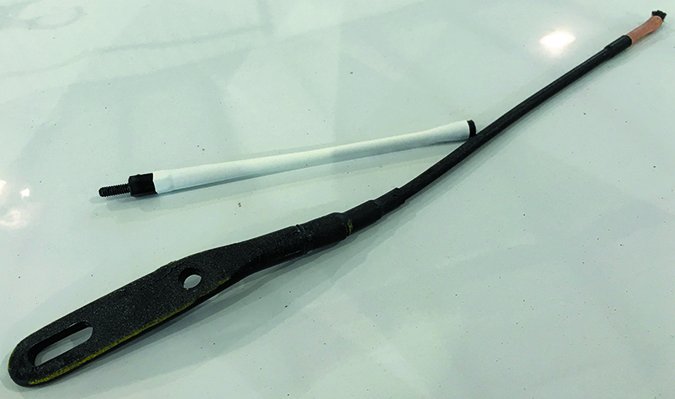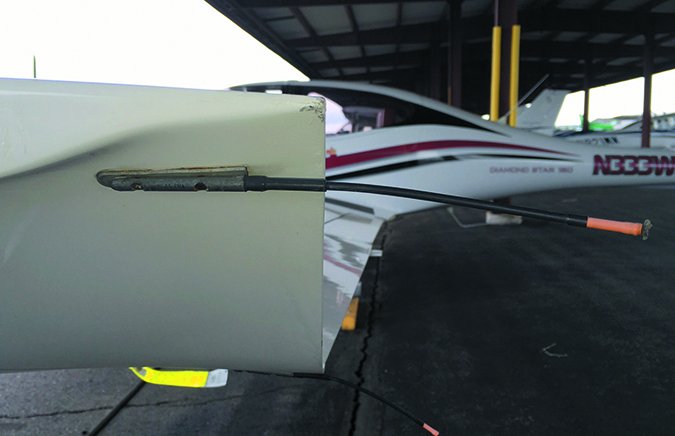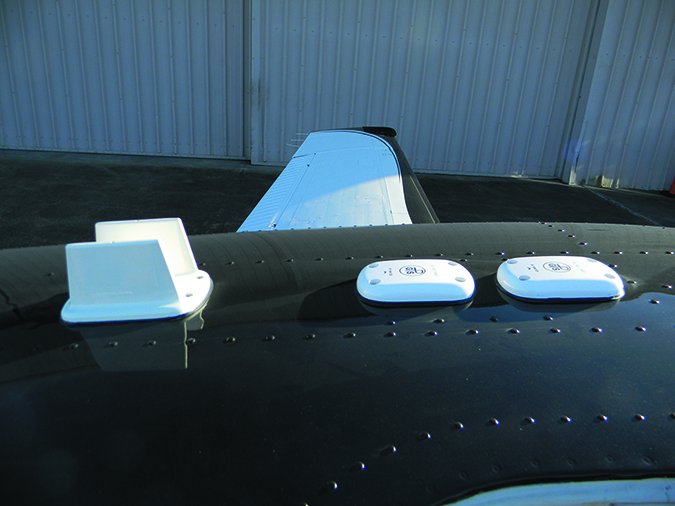If you ride long enough through snow, fog and desert dust, you’ll likely hear the audio signatures of static built up on the airframe. It can be severe enough to shut down a comm and nav receiver. The troubleshoot chase can be as frustrating for the techs as it is for pilots because everything will likely work perfectly on the ground. Static discharge wicks should be the first accessories to consider, especially when committing to a new avionics installation. But antennas could be the culprit, too.
For this article, we talked with avionics manufacturers, aircraft manufacturers and technicians about the effects of airframe static buildup on new avionics gear, and why healthy static wicks can help. Here’s what we learned.
RFI 101

Anytime an aircraft flies, the friction of the air over the aircraft’s skin causes the aircraft to build up static electricity. Discharge of the electricity can generate radio frequency interference (RFI) or static noise level. RFI can become serious enough to interfere with comm and nav radios to the point that reception becomes impossible. Any particulate matter in the air, be it rain, snow, dust, sand or even volcanic ash, will cause more RFI to be generated as the material sticks to the aircraft and any protrusions, especially antennas, which is why they have an anti-static coating.
While RFI most often affects low-frequency and VHF comm and nav radios, it can adversely affect UHF ranges, which includes transponders.
When the charge reaches between 100,000 and 200,000 volts, the electrical fields on an airplane become concentrated on the extremities and air is ionized at the sharpest points on those areas. The voltage isn’t going to kill anyone; the current level is low. However, as it discharges into the surrounding air, it creates the RFI that interferes with radios.
In the 1940s, researchers developed static discharge wicks—we now call them static wicks—to remove the electrical charge from an airplane by discharging it harmlessly back into the air before RFI is created. It was actually Florida-based Dayton-Granger that patented the wick style of leading-edge discharger, and the company continues to advance the design and remains a leading supplier to this day.
Static dischargers of various designs have been standard equipment on many airplanes for decades—and they generally get ignored—and abused. Spend enough time in any packed aircraft hangar and you’ll likely get poked by one.
Static wicks are bonded to the metal structure of the airframe. Because they are constantly transmitting electrons into the atmosphere, they eventually wear out—or at least the tips do. Once that happens, RFI can develop on the airplane.

In addition to radio static, you may experience a corona discharge when flying in precipitation. Corona discharge involves a static charge so great that excess electrons start to ionize air molecules and form a visible corona around sharp objects on the airplane—the end of the prop, antennas or wing tips, for example. The effect is known as St. Elmo’s fire. A corona discharge, taken to its extreme, occurs when a spacecraft enters the atmosphere and ionizes the surrounding air, turning it into plasma and wiping out communications until the spacecraft slows.
There is also the condition of streamering, a type of transient electrical discharge that occurs when insulating fiberglass structures (including windshields) are exposed to large differences in voltage.
Wick it Away
Static wicks are high-resistance devices (anywhere from 6 to 200 megohms resistance) that have a much lower corona voltage than the surrounding airframe structure they are attached to. But it’s not simply a matter of slapping a wick to the airframe and calling it a day.
Static wicks are essentially useless if they aren’t correctly bonded to the surface, meaning there must be a conductive path from all parts of the aircraft to the wick. That can be a huge challenge on composite aircraft and one reason you might not find static discharge wicks on some Cirrus and Columbia models, to name a couple.

Static wicks are available with and without FAA and PMA approval and with various methods of construction. Dayton-Granger has PMA approval for a variety of discharge wicks for use on piston and jet aircraft. It also provides dischargers to OEMs. Dayton-Granger’s Javier Pacheco told us the company continues to advance its wick design, offering the Null Field discharger product, the Mircopoint discharger, the Carbonpoint discharger and a line of composite dischargers. The company also has a history of making high-quality aircraft antennas, plus lightning diversion strips.
No matter the manufacturer, prices can range from $40 to as high as $85 or more for a wick suitable for a single or twin, and far more for jets. In general, most wicks for singles and light twins measure roughly 7 inches long and weigh .50 ounces each.
Wichita, Kansas-based Aero-Mach Labs (which purchased longtime OEM supplier TCO Manufacturing a few years ago) sells its static discharge products to Textron for the current Cessna and Beechcraft product line, and its discharge wicks are on Eclipse jets.
Owners may struggle with getting the correct replacement, especially when sourcing them through mail-order supply houses. Aero-Mach’s Jon Snider told us selecting the correct replacement wick should be easy because it’s usually governed by the original type certificate of the aircraft, and replacement options are prescribed by the aircraft repair manuals.
“We build specific model numbered wicks for Cessna, for example. When it’s time to replace them, the repair manual says to replace the wick with a specific part number,” he told us. Parts supplier Aircraft Spruce and Specialty stocks a healthy supply of static dischargers for certified and experimental aircraft. It told us it can often provide the correct wick based on the model and vintage of the aircraft. Replacement options are plentiful.

Aero-Mach still makes vintage single-piece wicks found on older models, in addition to its new line of two-piece dischargers. These have a threaded base for easy replacement of broken wicks. While it’s possible that a wick can exit the airframe in flight—especially while flying in icing conditions—it’s more common for one to come off while on the ground. Maybe it’s the result of hangar rash or one gets snapped off by a refueling hose.
That’s why we prefer dischargers with a threaded base. If one snaps off, simply screw the stud of the replacement wick into the base. That’s a whole lot easier than riveting a new single-piece wick to the skin of the aircraft.
Progress at Cirrus
There is a difficulty in ridding static from a composite airframe. It’s not as simple as installing a wick by riveting an aluminum base to the aluminum skin of the aircraft to achieve conduction. Still, over the past few years, Cirrus Aircraft did extensive flight testing in hopes of reducing radio noise caused by p-static interference on its composite airplanes. As a result, a field service bulletin was created for third-gen SR20/22 models to include the installation of two static wicks on each end of the wing (just inboard of the wingtip), in addition to ones on the elevator and rudder. It also involves isolating metal structures and electrically bonding them. Metal structures on the SR airframe needing grounding may include the wing step, air conditioning vent, flap hinges and the cabin door, to name a few.
P-Stat Lesson: Worse in Snow
As a dedicated student of aviation, I’d read many accounts of static from rain and snow wiping out the Morse Code A and N signals in the headset, which led to some crashes into high terrain in IMC. From time to time I’d experienced static-electricity-induced St. Elmo’s fire when flying in precip. In piston singles, it would appear as purple flames around the outer few inches of some or all of the prop disc.
One night in a Learjet, it manifested as eerie purple fingers stretching forward many yards into the night from the nose of the airplane and tip tanks. Never did it adversely affect the radios, although after we landed the Lear, the captain showed me where the paint had been removed from the very front of the nose and tip tanks and said, “St. Elmo always leaves his mark.”
I’d heard that static wicks could wear out, but never had much respect for the condition of the static wicks on an airplane I was flying until what I thought was going to be a routine 90-mile flight one night. In the family Cardinal with my wife and daughter, we flew into the snow that was forecast about halfway along our route from Cadillac, Michigan, to Grand Rapids. It was standard Michigan IFR winter weather—the cloud bases were we’ll above our altitude and it was snowing. Big deal. There was no risk of icing and it was cold enough that the snow wouldn’t be wet and block the air filter, requiring use of carb heat.
As we flew along, p-static began to build in the headphones. I had that happen a time or two before, and it always cleared itself within a few minutes. This time it didn’t. It got so intense that I could not hear the controller or anyone on the frequency. In addition, the needles for both VORs began to oscillate randomly. A quick check resulted in hearing only static, no identifiers, on both radios.
Turning on the landing light revealed that we were flying in moderate to heavy snow. I knew snow was worse than rain for generating p-static, but I’d never encountered anything like this. I knew it was snowing in Grand Rapids and forecast to continue, so I started considering turning back to Cadillac where it should just be decent VFR with a high overcast. At that point I recalled something I’d learned when encountering St. Elmo’s fire and a remark made by an old freight dog.
I held my right hand out in front of me, just above the panel, palm down, fingers spread and moved it toward a spot about two inches from the windshield and slowly swept it left and right. Just as I’d experienced with St. Elmo’s fire, tiny purple sparks jumped from under my fingernails to the windshield. I’d thought it was strange and fascinating back then; however, this time it apparently also served to discharge the static buildup on the airplane. The p-static in the radios went away, the VORs returned to proper functioning and I re-established contact with the controller.
After about five minutes, p-static started building again, so I did the hand and windshield thing again. I did it one or two more times before the intensity of the snow diminished and the worn static wicks could handle the static buildup, and I shot a routine approach into Grand Rapids. The next day I called my mechanic and arranged for a new set of static wicks for the airplane.
Are New Avionics More Immune?
Yes and no. We asked Garmin engineers about the effects of RFI on its retrofit and OEM avionics, including its most modern integrated suites for jets. One said that some modern systems are impervious to the effect (including GPS receivers) because GPS operates at such a high frequency. However, navs, comms and audio systems operate at lower frequencies and are much more susceptible to static interference if the aircraft has worn or missing static wicks. As one engineer put it, “The importance of static wicks is about the same for a 50-year-old airplane with old avionics as it is for a brand-new one with an ultra modern glass cockpit.”
Avidyne’s engineering division said it uses several approaches to combat RFI/EMI issues, including ground plane planning, providing low impedance return paths for RFI/EMI, board-level shielding, differential signaling and external signal filtering.
Still, all of this effort has little effect on in-band noise sources, particularly in VHF. As Avidyne explained, as static charges build, move and collapse on the airframe, very wide-band RF energy is released; some amount of this energy will fall in-band for the VHF and other RF receivers. The in-band component of the static noise is picked up by the antenna and amplified in the receiver as if it were the intended signal.
“There is very little that can be done about this at the avionics equipment level, and in this case, preventing the static buildup is the only good solution,” it told us.
The takeaway to this article is simple and complicated. From our shop experience chasing RFI interference problems, static discharge wicks may not be the cure-all. We’ve flown aircraft without static wicks in prime p-static conditions and enjoyed flawless performance, while ones equipped with wicks caused heartburn.
As Avidyne put it: “Static buildup is a very real issue that cannot be mitigated at the equipment level. If the aircraft OEM intended static wicks to be installed, it had a reason for it, and if it didn’t, it’s still probably a good idea.”


